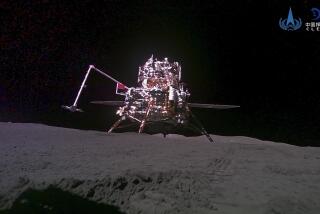Moon is wetter, chemically more complex than thought, NASA says
- Share via
The moon is a much wetter — and more chemically complicated — place than scientists had believed, according to new data released Thursday by NASA.
Last year, after the space agency hurtled a rocket into a frozen crater at the moon’s south pole and measured the stuff kicked up by the crash, scientists calculated that the plume contained about 25 gallons of water. But further analysis over the last 11 months indicates that the amount of water vapor and ice was more like 41 gallons — an increase of 64%.
“It’s twice as wet as the Sahara desert,” said Anthony Colaprete, the lead scientist for the Lunar Crater Observation and Sensing Satellite, or LCROSS, mission at NASA Ames Research Center in Northern California.
The instruments aboard the satellite, including near-infrared and visible light spectrometers, scanned the lunar debris cloud and identified the compounds it contained. They determined that about 5.6% of the plume was made of water, give or take 2.9%. It also included a surprising array of chemicals, including mercury, methane, silver, calcium, magnesium, pure hydrogen and carbon monoxide.
The findings were reported in six related papers published online Thursday by the journal Science.
“The lunar closet is really at the poles, and I think there’s a lot of stuff crammed into the closet that we really haven’t investigated yet,” said Peter Schultz, a planetary geologist at Brown University in Providence, R.I., and one of the LCROSS team members.
The new measurements allowed Colaprete to estimate that the entire Cabeus crater could hold as much as 1 billion gallons of water.
Potentially, that would be really handy for future space explorers who might use the moon as an interplanetary way station. Along with providing water to drink, it could be mined for breathable oxygen and used to make hydrogen fuel for long-distance spacecraft.
“You can’t take a lot of big things to the moon and you can’t take much water, so we’re learning to live off the land,” said Lawrence Taylor, a planetary geochemist at the University of Tennessee in Knoxville, who was not involved in the studies.
However, plans to develop a space colony on the moon were put on hold by the Obama administration this year.
The scientists picked their impact spot with care. Because the moon has but a vanishingly thin atmosphere, any water on the surface would eventually evaporate in all but the coldest regions. But in the depths of the Cabeus crater, which is shrouded in permanent darkness, temperatures hover around 40 degrees above absolute zero. In such extreme cold, water gets stuck to the soil, unable to move.
“It’s kind of like when you put your tongue on the flagpole in freezing weather,” Schultz said. “The atoms got stopped dead in their tracks.”
If it is indeed stuck on grains of moon dirt, it would be relatively easy to collect, the researchers said.
Even better, more water may be trapped outside the permanently shadowed regions, which are brutal places for machines to work, Colaprete said.
For scientists studying the evolution of the moon, equally intriguing was the assortment of chemicals detected in the plume. Not all of the hydrogen was attributable to water.
How all this stuff got to moon is a matter of much debate. Some scientists say it may have accumulated from bombardment by the solar wind, icy comets or by both. Others theorize that some of the water and chemicals were already part of the lunar material when the moon broke off from the primordial Earth.







